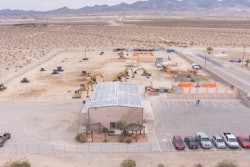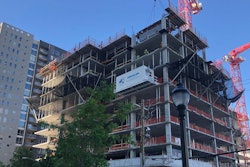
When I was in the eighth grade, I started working in a cabinetry shop, sparking an interest in construction that would change the course of my life. The idea of building something out of nothing, of creating a project that was lasting and meaningful, fascinated and inspired me. To this day, I’m still passionate about learning how things are built.
After multiple decades in the construction industry, and after building a family and having a son, I’ve come to appreciate that what makes this industry’s work so impactful is not just what we build, but also what we leave behind in the process. I’ve developed an increasing appreciation not just for building things, but for building better. Those of us in construction leave a legacy behind, one that will outlast all of us. I want to leave a legacy that I can be proud of, and that sets my son, and his future children, up for a healthy future.
Construction's Footprint on the World
While the construction industry is responsible for incredible feats of engineering, and for building the places where we live, work, learn, play—and the infrastructure that powers and brings these places to life—its impact on the environment is undeniable. The construction industry is one of the largest industries in the world, with buildings accounting for nearly 40% of annual global carbon emissions. According to the World Green Building Council, construction materials specifically account for approximately 11% of global carbon emissions. And according to a report from Transparency Market Research, the volume of solid construction waste generated worldwide every year clocks in around 1.3 billion tons. This number is expected to nearly double to 2.2 billion tons by 2025.
One of the causes of this waste comes from people working off of outdated information, showing up to the wrong jobsite at the wrong time, with the wrong materials and equipment. Often, there’s one culprit that lies at the heart of these inefficiencies: outdated communication channels such as fax, phone and paper. These cause poor communication, which can lead to costly rework and immense time and material waste. In other words, this waste is avoidable.
In recent years, the industry—and owners in particular—have turned their attention to tackling this growing challenge. This in turn has put pressure on general contractors to deliver more sustainable projects and track their ESG metrics. In a recent McKinsey study, where 100 senior construction executives were asked what trends they expected to accelerate due to the COVID-19 crisis, 53% cited sustainability.
But this move toward sustainable construction began long before the pandemic. Businesses are increasingly looking for ways to better track and report on their Environmental, Social and Governance (ESG) efforts, with an initial focus on impacting climate change such as carbon, waste, and energy usage. Energy use involves both operational carbon and embodied carbon. Operational carbon is from the in-use phase of a structure. Embodied carbon, on the other hand, includes carbon from the manufacture, transportation, and assembly of materials used to produce a structure (commonly thought of as all the greenhouse gas emissions before the doors of a building open).
Notably, businesses are using digital tools to track and report on their ESG efforts. While technology offers a wide array of solutions, connected technology—which connects people, systems, and data all in one place—will be the true game changer when it comes to reducing construction’s impact on the environment. Unlike point solutions, connected technology reduces the miscommunication and errors that lead to rework, which cause a significant amount of construction waste. Connected technology also gives teams a more holistic picture of their data, enabling them to make better decisions so they can build more sustainable and resilient buildings, emit less carbon, and reduce their overall environmental impact.
While there is a growing recognition that businesses need to track and reduce their carbon footprint, new environmental legislation may move faster than many companies have prepared for and force businesses into a space where they may not be equipped. The truth is, the process of measuring and tracking one’s environmental impact can be complex and challenging.
Ways to Improve Construction Sustainability
There are two key pieces to improving one’s ESG efforts. The first is to bring experts, across various teams and disciplines, together to collaborate and find ways to build more sustainably through improved design and construction processes. Connected technologies support this by bringing all people, systems, and data under one roof to improve transparency and reduce the inefficiencies in construction, thereby reducing costly rework and waste.
The other big component of ESG efforts comes down to tracking and reporting on environmental impact and carbon emissions. This is likely to soon become a requirement of construction companies and will ultimately create more opportunities to build more efficiently as the data is collected, tracked, analyzed and used to provide predictive insights to make informed, data-driven decisions. Building embodied carbon tracking and reporting holistically into connected platforms takes time and collaboration, but it has the potential to revolutionize the industry's ESG efforts.
The construction industry is taking steps in the right direction. One of the companies leading the charge has been Skanska, which has become a global sustainability leader in the industry today. Among many other sustainability “firsts,” Skanska was the first international general contractor ever certified under the ISO 14001 standard. Companies under this framework continually improve their environmental performance and ensure compliance with any new regulations or legislation.
“That became the foundation of how we looked at doing the right thing, both by the planet and by the communities we worked in,” said Steve Clem, head of sustainability for Skanska’s U.S. Building Operations. “Instead of thinking about how to do less harm, we started thinking about how we can do good by the environment, how we can ingrain sustainability into our core values, and how we can leverage the supply chain and everything else we influence to make a difference.”
But making this difference goes beyond supporting today’s teams. It’s also about building tools that can impact countless generations to come. A big piece of moving toward a climate-conscious future is having access to better data and guidance on how to reduce overall emissions. One way connected technology delivers on this is by helping teams better leverage their data so they can improve the way they build and lessen the environmental impact for future generations.
As more businesses adopt these ESG-forward digital tools, tracking and recording carbon emissions will become as essential as tracking and reporting on one’s safety, financials or productivity.
There is an enormous opportunity ahead to further drive ESG efforts in the industry. Collectively as an industry, we have the incredible opportunity to leave behind a positive and lasting legacy for future generations. Together, we can build a better, more sustainable future.


















